Hitsumabushi: How to Eat, Best Restaurants in Nagoya and Tokyo

Hitsumabushi is a famous Japanese eel originating in Nagoya and Aichi Prefecture. Learn how to eat hitsumabushi and recommended restaurants in Nagoya and Tokyo.
Hitsumabushi: Famous Eel Cuisine from Nagoya
Unadon (eel rice bowl) is a Japanese traditional dish that stands along sushi, tempura, and ramen.
In Nagoya and the entire Aichi Prefecture, there is a local dish called Hitsumabushi, which closely resembles the unadon.
Hitsumabushi is a dish where grilled eel is finely chopped and mixed with rice. The name comes from the idea of mixing (or tossing) rice and eel in a wooden container called an "ohitsu."
At first glance, hitsumabushi looks very similar to unadon, but in fact, it is enjoyed in a completely different way. As the title suggests, the key point is that you can enjoy "three different flavors in one serving."
5 Steps to Eating Hitsumabushi
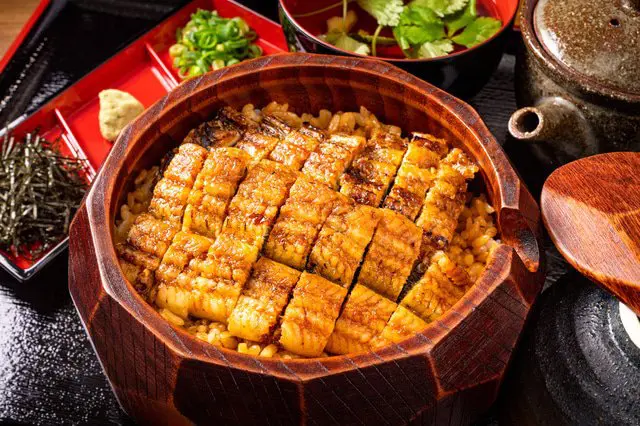
Photo by Pixta
When you order hitsumabushi, you receive a tray with four different bowls.
The main bowl contains rice topped with eel and seaweed. The difference from unadon is that the eel is finely chopped and there are other ingredients such as seaweed included, apart from the eel.
Now, let's proceed to explain the five different ways to enjoy hitsumabushi, which are distinct from unadon.
STEP 1. Divide the contents of the bowl into four parts

First, using a spoon or a rice paddle, divide the rice, eel, and other ingredients in the main bowl into four sections.
STEP 2. Serve the eel and rice on a small plate

Next, pick up one of the divided sections and transfer it to your serving plate.
Once transferred, all that’s left is to enjoy your meal. You can savor the same sweet, rich flavors as a regular unadon.
STEP 3. Mix the condiments, eel, and rice before eating
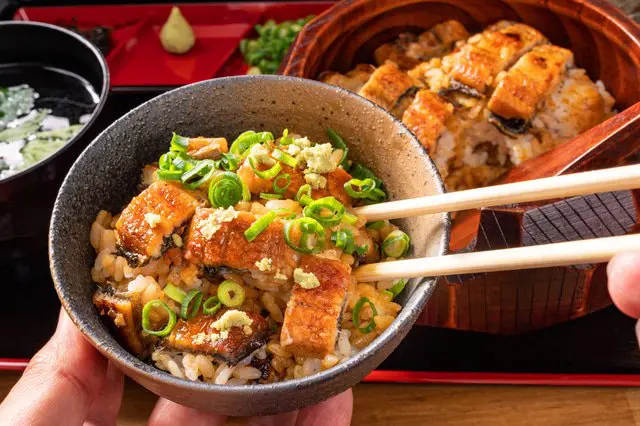
Photo by Pixta
After finishing the portion you transferred, take another block and transfer it to your serving plate. Unlike before, this time, also transfer the condiments (such as wasabi or green onions, which are spices) that are served separately into the plate.
The types of condiments vary depending on the restaurant—such as wasabi or pickles.
At Nadai Unatoto Asakusa, which we visited, they serve wasabi. Be sure to mix everything well so that the condiments spread throughout. The spiciness and aroma of the condiments will permeate the dish, adding a refreshing flavor that wasn't present the first time.
STEP 4. Eat with tea or broth

Photo by Pixta
Now, having eaten about half of it, you might start to feel a bit more full. How do you enjoy the third section?
After serving rice and eel, pour in the soup from a black container. The soup is a light, clear dashi broth. Depending on the restaurant, some use tea instead of dashi, turning the dish into a kind of ochazuke (tea poured over rice).
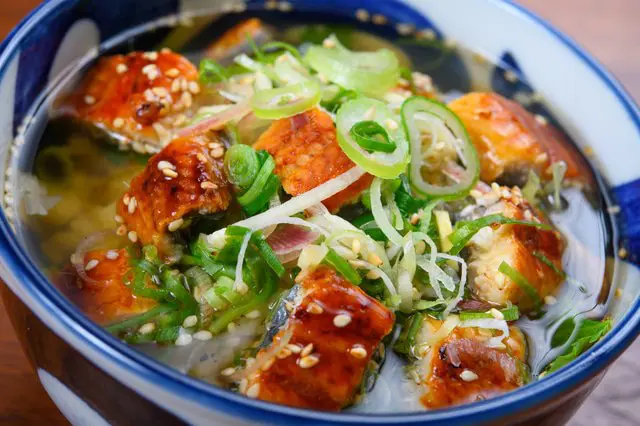
Photo by Pixta
Thanks to the broth, the rich flavor of the eel feels even more refined. Additionally, even if you’re full, you can enjoy it without overdoing it—simply sip it down smoothly.
STEP 5. Finish with your preferred way of eating
By this point, you've enjoyed the eel and rice in three different ways. Which method was your favorite? For the final leftover block, try eating it in your most favorite way.
The Origin of Hitsumabushi
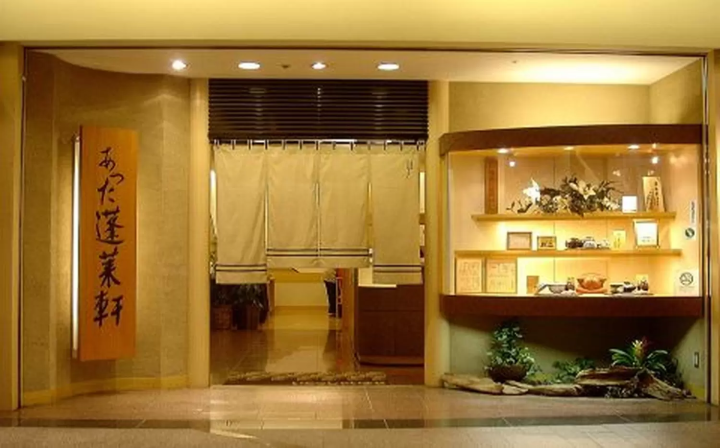
Picture courtesy of Hot Pepper Gourmet
Hitsumabushi is said to have originated at Atsuta Horaiken, located in front of Atsuta Shrine in Nagoya.
Atsuta Horaiken is a traditional Japanese restaurant established in 1873. Originally, their specialties were grilled eel and chicken (kashiwa). It is also said that they frequently delivered meals as well during that time.
When delivering food with a ceramic bowl, it often ends up broken when returning. To solve this problem, the店 owner invented a large wooden rice container called an “ohitsu,” which wouldn’t break. They began using it to hold several servings of eel rice bowls.
However, with this method of delivery, it was common for customers to eat the eel first, leaving rice uneaten. To address this, the eel was finely chopped and mixed into the rice before serving, which became very popular.
Using a large ohitsu, rice and eel are tossed (mixed) together. This is the origin of the name "hitsumabushi." Later, trying out pouring broth over it (ochazuke style) also received high praise, and this way of eating became popular. Additionally, single-serving ohitsu containers became the standard.
Famous Hitsumabushi Restaurants in Nagoya
Within Nagoya city and Aichi Prefecture, there are several renowned establishments for hitsumabushi. Here are some of the most famous spots.
Atsuta Horaiken
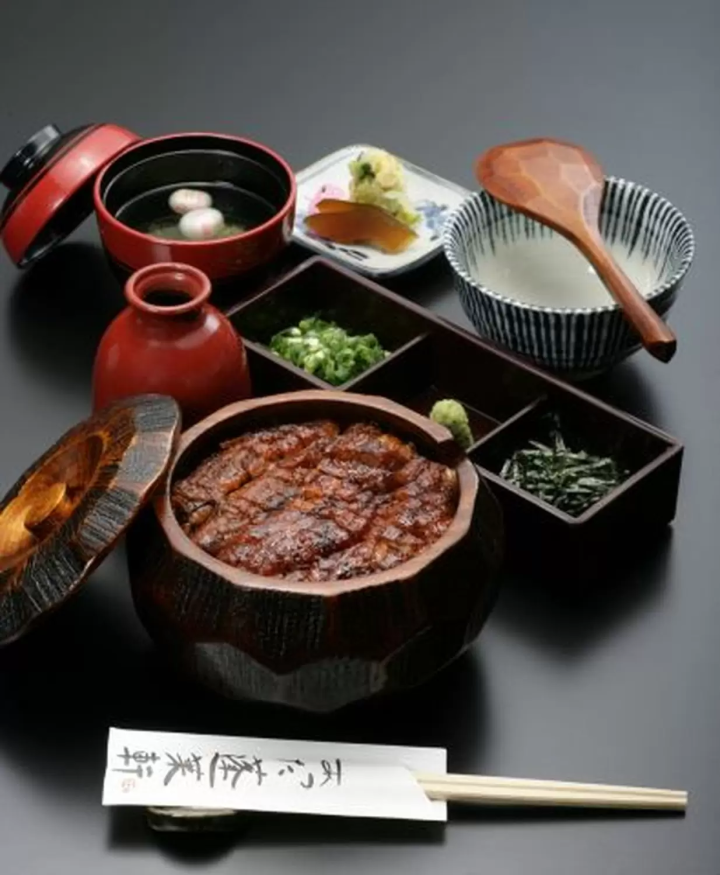
Picture courtesy of Hot Pepper Gourmet
This is the famous restaurant where hitsumabushi originated. Since its founding, the restaurant has continuously replenished its secret sauce, which has developed a rich flavor over 140 years. The eel is dipped in this sauce and then grilled over the highest quality Binchotan charcoal.
Currently, they operate four branches within Nagoya.
Atsuta Horaiken Main Store
Address: 503 Kobe-cho, Atsuta ward, Nagoya, Aichi Prefecture
Business Hours: 11:30–14:00 (Last Order), 16:30–20:30 (Last Order). Closed every Wednesday and the second and fourth Thursday (open on holidays; some days off may vary)
Official Website: https://www.houraiken.com/
Hitsumabushi Bicho
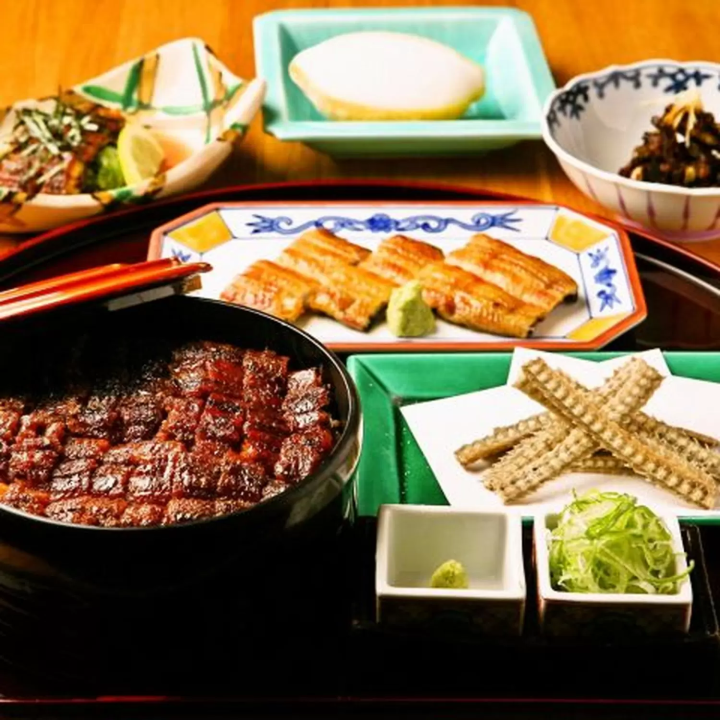
Picture courtesy of Hot Pepper Gourmet
Bichō Hitsumabushi, which has branches not only within Aichi Prefecture and Nagoya City but also in Tokyo and Osaka. Its特色 is the use of a cooking method called “Jijiyaki,” where the eel is grilled over high heat without steaming. Additionally, by using Tamari soy sauce and mirin from Aichi Prefecture, the dish achieves a crispy skin while maintaining tender and flavorful flesh.
Bicho Main Store
Address: 5-176-1 Shimo-Koguchi, Okuwa-cho, Niwa-gun, Aichi Prefecture
Business Hours: Weekdays 11:30–14:30 (Last Order 14:00), 17:00–20:30 (Last Order 20:00).
Weekends and holidays 11:30–15:00 (Last Order 14:30), 17:00–21:00 (Last Order 20:30).
Closed on Mondays (if Monday is a holiday, closed on Tuesday).
Official Website: https://www.hitsumabushi.co.jp/
Hitsumabushi Hanaoka
Located in Sakae, Nagoya's largest entertainment district, is Hitsumabushi Hanaoka. Its unique feature is using plum (ume) in the final ochazuke (rice soaked in tea). Plums are said to aid in digestion of eel's oil and help settle the stomach.
The restaurant also prides itself on using locally sourced rice, demonstrating a strong commitment to quality ingredients.
Hitsumabushi Hanaoka
Address: 3-8-115 Sakae, Naka Ward, Nagoya, Aichi Prefecture
Hours: 11:00–16:00 (Last order 15:00), 18:00–22:00 (Last order 21:00). Open daily, no holidays.
Official website: https://hitsuabushi-hanaoka.shopinfo.jp/
Where to Enjoy Hitsumabushi in Tokyo
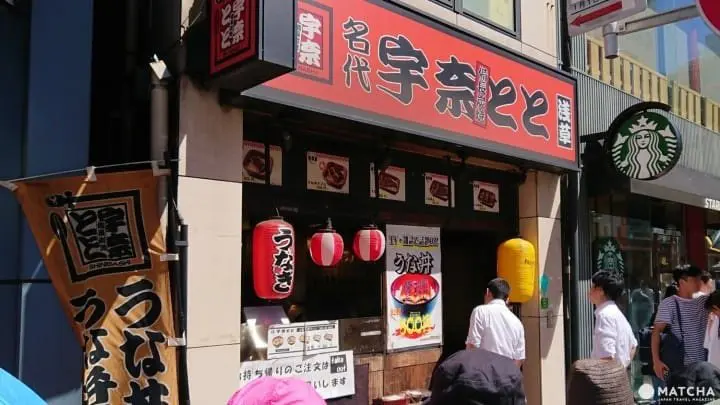
Hitsumabushi is a famous dish from Nagoya, but in recent years, you can also find it in other regions such as Tokyo and Osaka. For example, Nadai Unatoto Asakusa is one of those places.
Nadai Unatoto is a chain restaurant where you can enjoy eel dishes like hitsumabushi and eel rice bowls at affordable prices. In addition to Asakusa, they also have locations in popular sightseeing spots such as Shinjuku and Osaka Umeda.

Photo by Pixta
Other restaurants where you can enjoy hitsumabushi are gradually increasing outside Nagoya city as well. After experiencing the deliciousness of hitsumabushi, be sure to visit Nagoya, the authentic birthplace of this dish!
Nadai Unatoto Asakusa Branch
Address: 1-5-2 Hanakawado, Taito-ku, Tokyo
Hours: Open daily from 11:00 to 22:00
Official website: https://www.unatoto.com/shop/asakusa/
Read also
MATCHAで編集やってます植松です。87世代。









































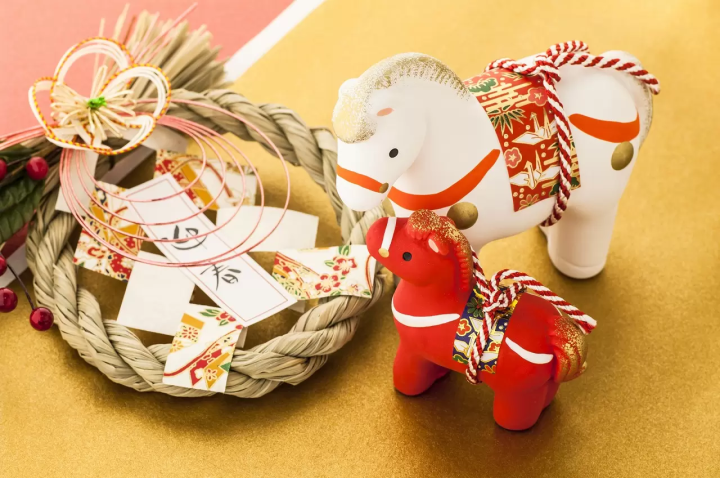

![[Kanazawa] Enjoy the world of gold leaf to the fullest in the city with the highest production volume in Japan](https://resources.matcha-jp.com/resize/720x2000/2025/11/12-249564.webp)
![[2026] Family Winter Trip to Suzuka Circuit! – For Both Day trips and Overnight Stays!](https://resources.matcha-jp.com/resize/720x2000/2025/12/26-254097.webp)

![[2026] Top 5 Strawberry Picking Spots in Tokushima, Naruto| Farms and Access Guide for January to May](https://resources.matcha-jp.com/resize/720x2000/2025/03/06-227165.webp)
![[Yamanashi/ Hokuto City] 4 Hot New Spots Opening in 2026](https://resources.matcha-jp.com/resize/720x2000/2025/12/12-252747.webp)